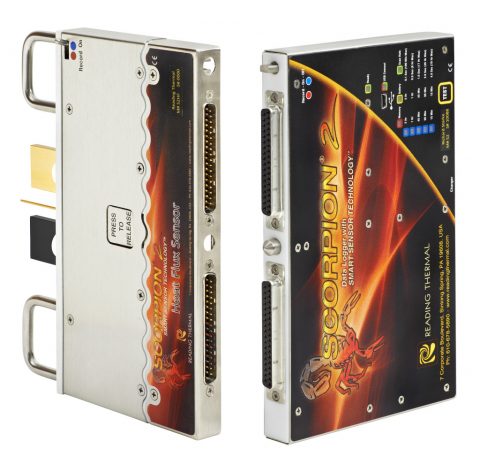Take advantage of thermal profiling for the baking industry with solutions from Reading Thermal.
Reading Thermal, a product brand of Reading Bakery Systems, is located in Sinking Spring, Pennsylvania. Our heat transfer experts have been studying and measuring the commercial baking process for 25+ years. We manufacture and support the SCORPION® 2 Profiling System and Data Logger which has become a standard in the baking industry.
Connecting our innovative smart sensors and sensor arrays to the SCORPION® 2 Profiling System and passing them through the oven with your product enables the system to capture the four main baking parameters:
- Temperature (including the temperature of both the air and the oven belt surface)
- Heat flux (energy transfer)
- Humidity
- Airflow (velocity).
Why Thermal Profiling is Important
Product level temperature throughout an oven can make the difference between optimum quality and throughput – and wasteful, under-baked, or burnt product. The process of fermentation, product swelling, moisture evaporation, flavor development, and surface coloring are all time and temperature dependent. For example, during the baking process:
- Insufficient heat can cause crusts to be brittle or dry,
- Insufficient heat can create products that are too light in color.
- Insufficient heat can create a structure that is too dense.
- Excessive heat can cause the bottoms of loaves to burn before the crusts are properly browned.
- Excessive heat will cause moisture to evaporate too quickly and the dough will not rise evenly.
State-of-the-Art Reading Thermal Sensors
Temperature: Oven temperature affects oven-spring, drying and dehydration, and color formation during baking. Insufficient or excessive heat can also lead to unwelcome changes in texture and taste. The Scorpion® 2 Temperature Sensor Array is designed to measure temperature at product level, in fixed positions across the conveyor, and delivers a precise picture of temperatures from side-to-side and end-to-end.
Humidity: In a thermal process, humidity interacts with the product. The moisture in the environment often comes from the product itself and presents a delicate balance that affects finished product quality in a variety of ways (crust, texture, shelf life, etc.). The SCORPION® 2 Digital Humidity Sensor is designed to measure the moisture content of the thermal environment in both heating and cooling processes. It is applicable to proofers, ovens, dryers and cooling tunnels.
Heat Flux: The best indicator of oven performance during baking in terms of the product is heat flux. Many bakers use oven heat flux profiles when trying to produce the same product on two different lines. (The heat flux profiles must match.) The SCORPION® 2 Heat Flux Sensor is designed to measure convective and radiant heat fluxes at product level and display the results in Btu/hr·ft2 or W/m2.
Air Velocity: The airflow in convection ovens comes primarily from the air distribution plenums. In radiant ovens, the airflow comes from the moving conveyor, the exhaust system, and natural combustion air currents. Measuring the oven air velocity with the SCORPION® 2 Air Velocity Sensor will help you spot airflow differences between baking zones and unwanted air currents at the entrance or exit of the oven that result in inconsistent baking.
In the commercial baking industry, when you need thermal profiling solutions to monitor baking conditions, consider the state-of-the-art SCORPION® 2 Data Logger from Reading Thermal. Contact us online or call us at (610) 678-5890 Ext. 2 to learn more about them.

